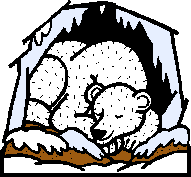

Hibernation is a state of inactivity and metabolic depression in animals, characterized by lower body temperature, slower breathing, and lower metabolic rate, to conserve energy, especially during winter. Hibernation may last several days or weeks depending on species, ambient temperature, and time of year.
Typically, the winter season for the hibernator is characterized by periods of hibernation interrupted by periodic euthermic arousals wherein body temperature is restored to typical values. Hibernation allows animals to conserve energy during the winter when food is short. During hibernation, animals slow their metabolism to a very low level to allow them to use their energy reserves, stored as body's fat, at a slower rate.
Animals that hibernate include bats, ground squirrels and other rodents, mouse lemurs, the European Hedgehog and other insectivores, monotremes, and marsupials. Although Pliny the Elder thought that swallows hibernated, and even a keen observer like the Rev. Gilbert White (The Natural History of Selborne) believed that, birds typically do not hibernate, instead using torpor, but an exceptional bird known as the Poorwill does hibernate.
Many experts believe that the processes of daily torpor and hibernation form a continuum.One animal that some consider to be a hibernator is the bear. However, the degree of metabolic depression is much less than what is observed in smaller mammals and many prefer to use the term denning. The bear's body temperature remains relatively stable (depressed from 37¡ C to approximately 31¡ C) and it can be easily aroused. In contrast, hibernating ground squirrels may have core body temperatures as low as -2¡ C. Some reptile species are said to brumate, or undergo brumation, but the relatedness of this phenomenon with hibernation is not clear.
Before entering hibernation most species eat a large amount of food and store energy in fat deposits in order to survive the winter. Some species of mammals hibernate while gestating young, which are born shortly after the mother stops hibernating.For a couple of generations during the 20th century it was thought that basking sharks settled to the floor of the North Sea and hibernated. Tracking devices installed on 20 basking sharks in 2002 dispelled this hypothesis.
Until recently no primate, and no tropical mammal, was known to hibernate. However, animal physiologist Kathrin Dausmann of Philipps University of Marburg, Germany and coworkers present evidence in the 24 June 2004 edition of Nature that the Lesser Dwarf Lemur of Madagascar hibernates in tree holes for seven months of the year. This is interesting because Malagasy winter temperatures sometimes rise to over 30 ¡C (86 ¡F), so hibernation is not exclusively an adaptation to low ambient temperatures.
The hibernation of this lemur is strongly dependent on the thermal behaviour of its tree hole: if the hole is poorly insulated, the lemur's body temperature fluctuates widely, passively following the ambient temperature; if well insulated, the body temperature stays fairly constant and the animal undergoes regular spells of arousal. Dausmann found that hypometabolism in hibernating animals is not necessarily coupled to a low body temperature.
Noise and vibration from snowmobiles, all-terrain vehicles and the like is said to sometimes awaken hibernating animals, who may suffer severely or die as a result of premature awakening in times of food shortage.
Hibernation Wikipedia